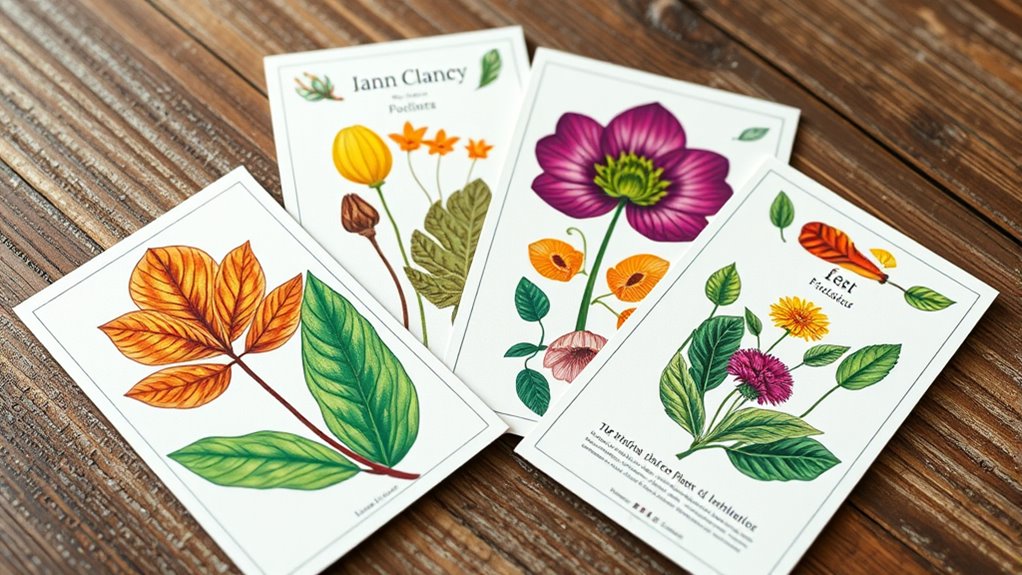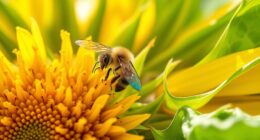If you’re looking to make plant identification easier, I recommend four top tools. The Leaf Identification Chart offers detailed illustrations of North American leaves, perfect for quick recognition. The Hedgewitch Botanical Oracle combines beautiful artwork with guided insights, ideal for exploration. A Field Guide to Bird Songs helps identify birds by call, while the Plant Parenting Book offers step-by-step ways to grow your garden. Keep going to discover how each of these tools can boost your plant confidence.
Key Takeaways
- The best botany identification cards combine high-quality visuals, accurate scientific information, and durable materials for reliable plant recognition.
- They vary in size and format, from pocket-sized for field use to large wall charts for classroom or group displays.
- Features like clear labeling, detailed illustrations, and habitat data enhance ease of identification for all skill levels.
- Complementary tools such as plant guides or audio bird call cards improve overall identification accuracy and learning.
- Choosing the right cards depends on portability, regional focus, content accuracy, and user-specific needs for outdoor or educational use.
Leaf Identification Chart – 50 Leaves Of North America, 28 X 40
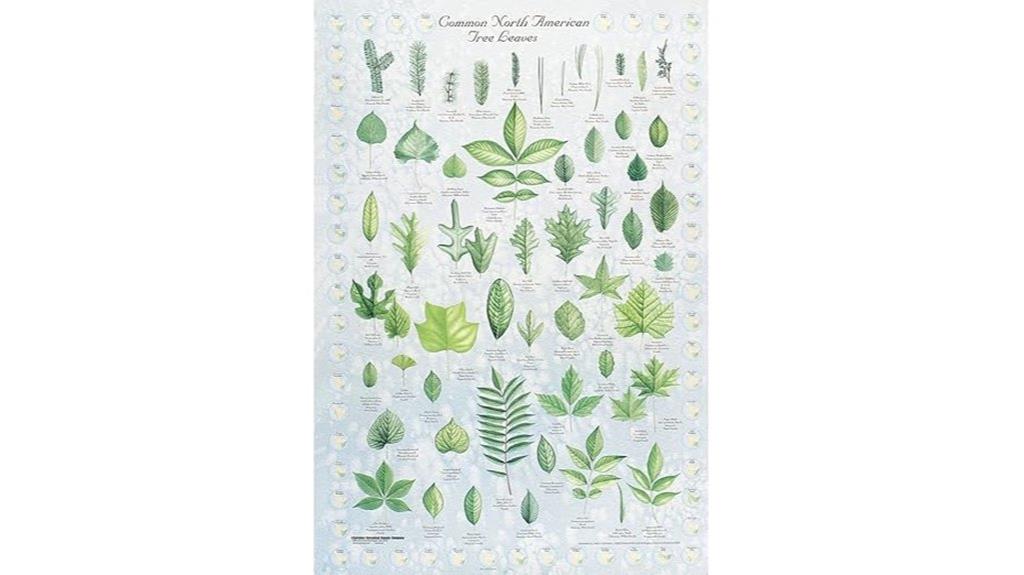
If you’re looking for a clear and all-inclusive tool to help identify North American leaves, the Leaf Identification Chart—featuring 50 different species—is an excellent choice. Measuring 28 by 40 inches, it’s oversized for easy viewing and detailed study. The chart features full-color illustrations of over 50 leaves, showing both common and scientific names, along with their general ranges. It’s perfect for classrooms or personal use, making botany and plant identification more accessible. I’ve found it’s a versatile educational resource that simplifies learning and helps users quickly recognize and differentiate various North American trees.
Best For: educators, students, and nature enthusiasts seeking a comprehensive and visually accessible tool for identifying North American leaves.
Pros:
- Over 50 detailed, full-color leaf illustrations for accurate identification
- Includes both common and scientific names, enhancing educational value
- Large 28 x 40-inch size for easy viewing and reference
Cons:
- May require wall space for display due to its oversized dimensions
- Limited to North American species, not suitable for identifying leaves outside this region
- Might be less effective for users seeking digital or interactive learning tools
Hedgewitch Botanical Oracle
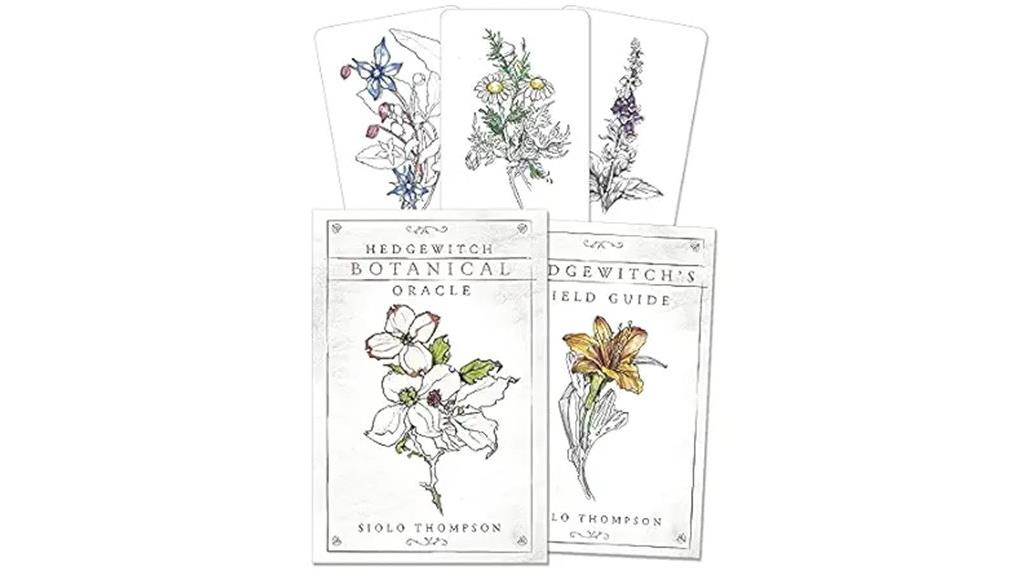
The Hedgewitch Botanical Oracle stands out as an excellent choice for nature lovers and herbalists who want a beautiful, intuitive tool for botanical identification and guidance. This 40-card deck features delicate, elegant artwork and a sturdy, magnetic-closure box, making it both functional and aesthetically pleasing. I’ve found it incredibly calming and insightful, especially when used alongside the all-encompassing 192-page guidebook. The deck’s minimalistic design and botanical focus foster a deeper connection with plants, whether for divination, herbal practice, or outdoor plant identification. It’s perfect for those who enjoy rule-breaking, intuitive readings and want a meaningful way to engage with nature’s wisdom.
Best For: nature lovers, herbalists, and green witches seeking a beautiful, intuitive botanical oracle for divination, plant identification, and herbal insights.
Pros:
- Stunning, elegant artwork that enhances the aesthetic and intuitive experience
- Comprehensive 192-page guidebook with detailed plant descriptions, history, and usage tips
- Durable, high-quality cards with a sturdy magnetic box that makes for easy shuffling and storage
Cons:
- No quick-reference index in the guidebook, which may slow navigation for some users
- Minor production issues reported, such as slight bends or residue on new cards
- Slightly limited to botanical and nature-based themes, less suited for traditional tarot readers
A Field Guide to Bird Songs: Eastern and Central North America
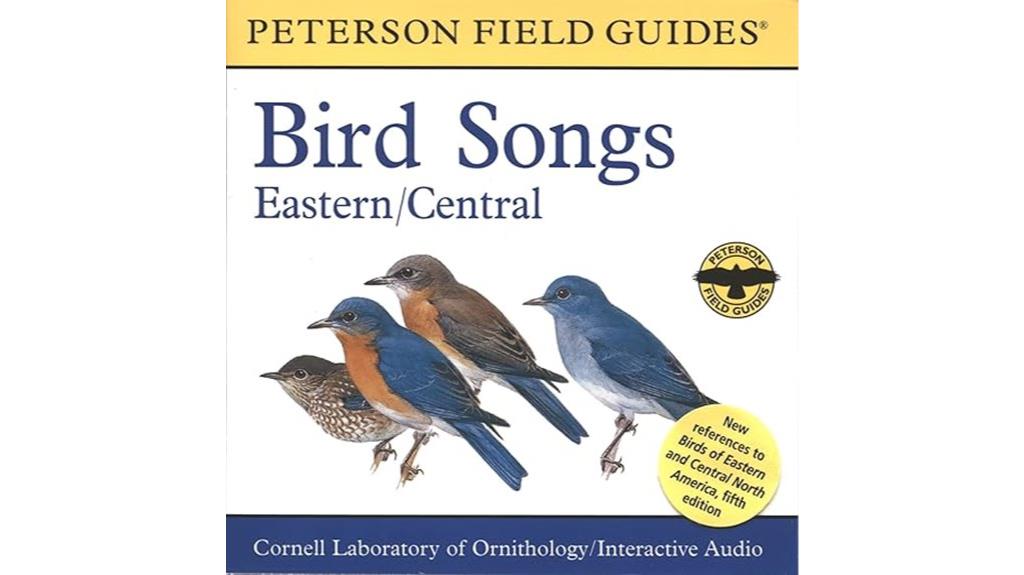
A Field Guide to Bird Songs: Eastern and Central North America stands out as an ideal resource for both beginner and experienced birders aiming to master bird calls. The accompanying CD offers clear narration, announcing each bird’s name before its call, making learning accessible. It’s perfect for identifying birds in yards, neighborhoods, and during outdoor trips. The well-organized calls, grouped by bird families, help users connect sounds with visual ID. The high-quality recordings and logical sequence enhance learning, while some wish for individual sound files and visual aids. Overall, it’s a highly effective tool that’s helped many improve their birding skills and enjoy bird sounds more deeply.
Best For: beginner and experienced birders who want to improve their ability to identify bird calls in various outdoor and neighborhood settings.
Pros:
- Clear narration with bird names announced before each call enhances learning.
- Well-organized calls grouped by bird families facilitate easier association between sounds and visual IDs.
- High-quality recordings provide accurate and enjoyable listening experiences.
Cons:
- Calls are grouped by family, making it challenging to focus on a single species repeatedly.
- Limited time dedicated to individual bird calls, which may hinder in-depth study of specific songs.
- Lack of visual aids like pictures to support quick visual identification alongside audio cues.
Plant Parenting Book: Easy Ways to Make More Houseplants, Vegetables, and Flowers
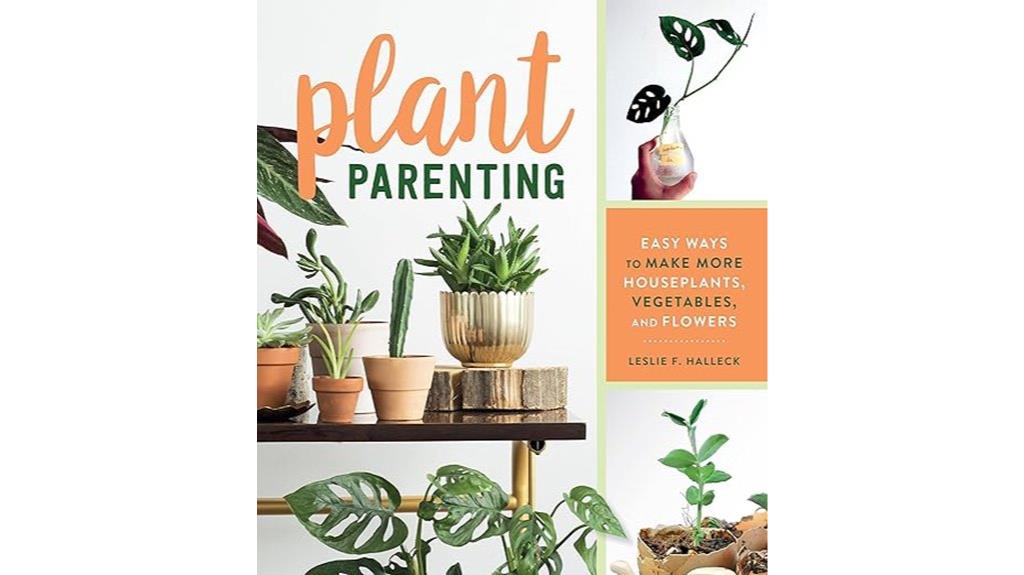
For anyone diving into plant propagation, the “4 Best Botany Identification Cards” are an invaluable tool. Pairing them with Leslie’s “Plant Parenting” book makes expanding your plant collection easier and more enjoyable. This in-depth guide is perfect for beginners and seasoned growers alike, covering techniques like seed starting, cuttings, and air layering with clear instructions and beautiful visuals. The detailed photos and illustrations demystify complex methods, boosting confidence. Whether you’re growing houseplants, vegetables, or flowers, this book offers practical tips that lead to successful propagation. It’s a must-have resource to inspire and empower your plant-growing journey.
Best For: beginners and experienced plant enthusiasts seeking clear, practical guidance on propagating houseplants, vegetables, and flowers with visual aids and step-by-step instructions.
Pros:
- Comprehensive coverage of various propagation techniques with detailed visuals.
- Suitable for all skill levels, from novices to seasoned growers.
- Inspires confidence and success through practical tips and beautiful illustrations.
Cons:
- May benefit from an expanded A-Z index for more plant species.
- Some readers desire additional examples tailored to different climates.
- The book might be less detailed on advanced propagation methods for experienced growers.
Factors to Consider When Choosing Botany Identification Cards
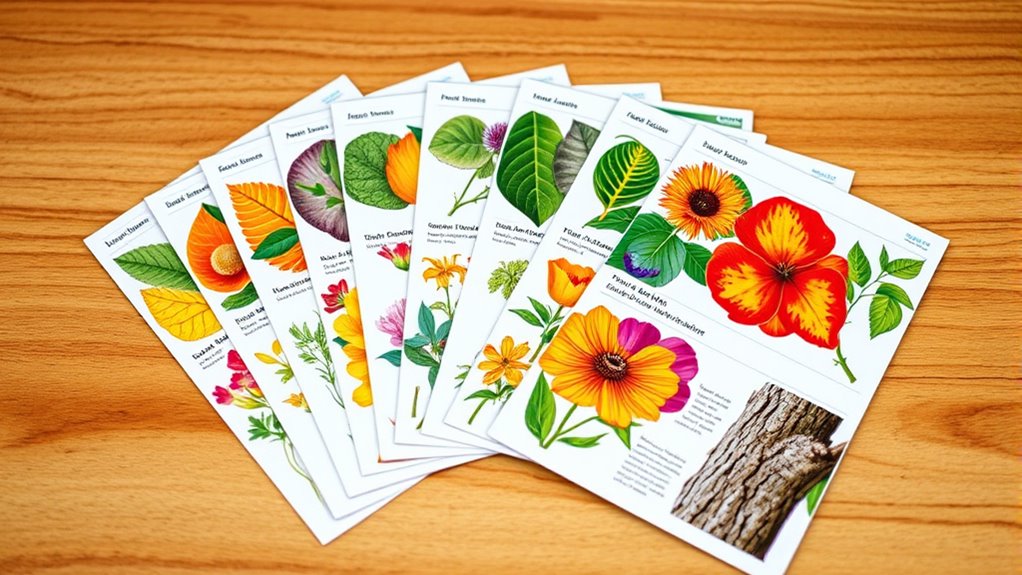
When choosing botany identification cards, I consider several key factors to guarantee they meet my needs. I look at durability to withstand handling, clarity for easy reading, and size for portability. Additionally, I prioritize accuracy in content and attractive design to make the cards both practical and appealing.
Card Material Durability
Choosing the right material for botany identification cards is essential because these cards often face frequent handling and exposure to outdoor conditions. Durable materials like laminated cardstock or plastic are better suited for this environment because they resist bending, tearing, and moisture. High-quality options often include UV coatings or water-resistant surfaces that prevent fading, staining, and damage from sunlight or rain. Selecting sturdy materials extends the lifespan of the cards, reducing the need for frequent replacements and maintaining their educational value over time. When choosing materials, consider environmental factors like humidity, temperature fluctuations, and physical wear. Prioritizing durability guarantees your cards remain intact and legible, making plant identification easier and more reliable in diverse outdoor settings.
Visual Clarity and Detail
High-quality visuals are the backbone of effective botany identification cards. Clear, high-resolution images with close-up shots reveal essential details like leaf venation, texture, and flower structures, making identification more accurate. Including multiple angles or magnifications showcases key features that are often missed with a single view. A clean, uncluttered design emphasizes botanical details, helping distinguish similar species easily. Accurate color representation is critical, as it allows users to identify plants under different lighting conditions without confusion. Well-labeled images, with both scientific and common names, facilitate quick recognition and reduce errors. Overall, sharp, detailed visuals combined with thoughtful design ensure the cards are user-friendly and dependable tools for plant identification.
Size and Portability
Selecting the right size for your botany identification cards is essential for ensuring they’re practical and effective. I recommend choosing a size that comfortably fits in your hand or pocket, making it easy to handle and transport during outdoor plant hunts. Smaller cards, like 3 x 5 inches, are perfect for quick reference in the field, offering portability without adding bulk. On the other hand, larger cards, such as 8.5 x 11 inches, provide more space for clear illustrations and detailed info, ideal for classroom or display purposes. Oversized cards, like 28 x 40 inches, work well for wall displays or group settings but aren’t practical for on-the-go use. The key is to find a balance between visibility and portability that suits your specific needs and activities.
Content Accuracy
Ensuring the accuracy of botany identification cards is vital for reliable plant identification and education. I look for cards that feature correct scientific names and taxonomic classifications, as these details guarantee I’m learning precise information. Reliable visual representations, like detailed illustrations or clear photographs, are essential for accurately recognizing key plant features. Including accurate data on habitat, range, and ecological preferences adds depth and correctness to the content. I also verify that all information is backed by reputable botanical sources, which boosts my confidence in its trustworthiness. Regular updates or reviews of the cards are important, since botanical classifications and scientific knowledge change over time. This ongoing accuracy guarantees I’m using current, credible information for effective learning and identification.
Design and Aesthetics
When choosing botany identification cards, their design and aesthetics play a crucial role in how effectively I can learn and recognize plants. Clear, vibrant images or illustrations that accurately highlight key features are essential for quick identification. A well-chosen color scheme, readable fonts, and a logical layout improve readability and keep the cards engaging. Design elements like borders, icons, and consistent styling create a cohesive look that helps me quickly distinguish different plant types. The overall aesthetic should balance beauty and practicality, making the cards attractive yet easy to interpret at a glance. High-quality printing and durable materials also ensure the cards look professional and withstand frequent handling, especially outdoors, maintaining their visual appeal over time.
Usability and Ease
To make the most of botany identification cards, their usability and ease of use are essential considerations. Clear, legible labels and organized layouts help me quickly identify plants and minimize confusion. Durable, high-quality materials with rounded edges make the cards easier to handle and less prone to damage during frequent use. Easy-to-understand language and straightforward visuals ensure I can recognize plant features efficiently, regardless of my experience level. The compact, lightweight design allows me to carry the cards easily into the field, making plant study more convenient. User-friendly features like alphabetical ordering or categorized groupings improve navigation, helping me find information swiftly. Overall, these aspects make botany cards more practical, saving time and enhancing my confidence during plant identification.
Educational Value
Choosing botany identification cards with strong educational value means looking for features that deepen my understanding of plants. I prioritize cards that include clear, accurate photos or illustrations, which make visual learning easier. Detailed info like scientific and common names, along with key identifying features, help me differentiate species confidently. Including range maps or habitat info connects plant characteristics to their geographic locations, enhancing context. Cards that share interesting botanical facts or uses keep me engaged and improve retention. Additionally, well-organized cards allow me to compare similar species effectively, making learning more efficient. Overall, educational value guarantees I gain a thorough understanding of plants, transforming simple identification into a meaningful learning experience.
Frequently Asked Questions
Are Botany ID Cards Suitable for Beginner Plant Enthusiasts?
Yes, botany ID cards are perfect for beginner plant enthusiasts. They simplify plant identification by providing clear images, key features, and easy-to-understand information. I’ve found them incredibly helpful when starting out because they make learning fun and accessible. Whether you’re exploring your garden or a nature walk, these cards boost your confidence and knowledge, making plant discovery an enjoyable and educational experience for beginners like you.
How Durable Are These Identification Cards Outdoors?
These identification cards are quite durable outdoors. I’ve used mine in various weather conditions, and they hold up well without tearing or fading quickly. The cards are usually laminated or made from sturdy plastic, which protects them from rain, dirt, and sun exposure. Of course, I recommend handling them gently and storing them properly when not in use. Overall, they’re designed to withstand outdoor adventures and help you identify plants easily.
Can These Cards Identify Rare or Exotic Plant Species?
Yes, these cards can help identify rare or exotic plants, but their effectiveness depends on the card’s database and level of detail. I’ve found that high-quality cards with extensive information can often recognize unusual species, especially if I’m familiar with their characteristics. However, for extremely rare or newly discovered plants, I might need to consult additional resources or expert guides to confirm the identification accurately.
Do the Cards Include Information on Plant Care and Maintenance?
Yes, many of these botany identification cards include helpful information on plant care and maintenance. I find that having care tips right on the card makes it easier to keep my plants healthy and thriving. They often cover watering, sunlight, and fertilization advice, which is super handy. These details help me feel more confident in caring for my plants and ensure I give them the right environment to flourish.
Are Digital or Printable Versions Available for These Identification Cards?
Yes, both digital and printable versions of botany identification cards are available. I love having digital options because I can access them on my phone or tablet anytime I need quick plant info. Printable cards are great for offline use or classroom settings. I recommend choosing based on your needs—digital for convenience and portability, or printable for hands-on learning and easy sharing.
Conclusion
As I’ve discovered, the right botany identification card can truly transform how you connect with plants. It’s funny how a simple tool can turn a casual walk into a discovery adventure, almost like the universe nudging us to appreciate nature’s beauty. Whether you’re a beginner or a seasoned plant enthusiast, these cards make identifying and caring for plants feel effortless. Give it a try—you might just find yourself falling in love with plants all over again.
